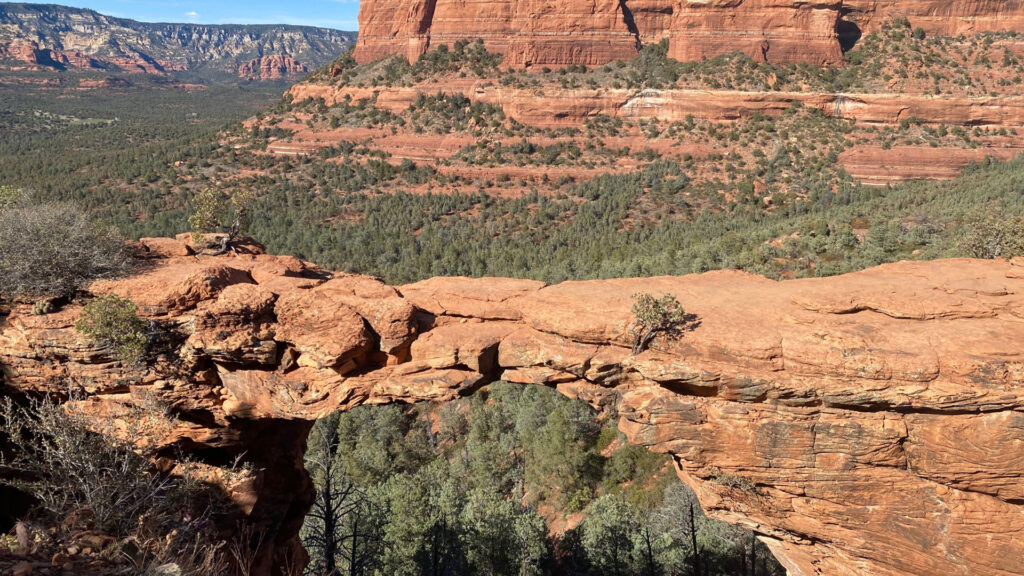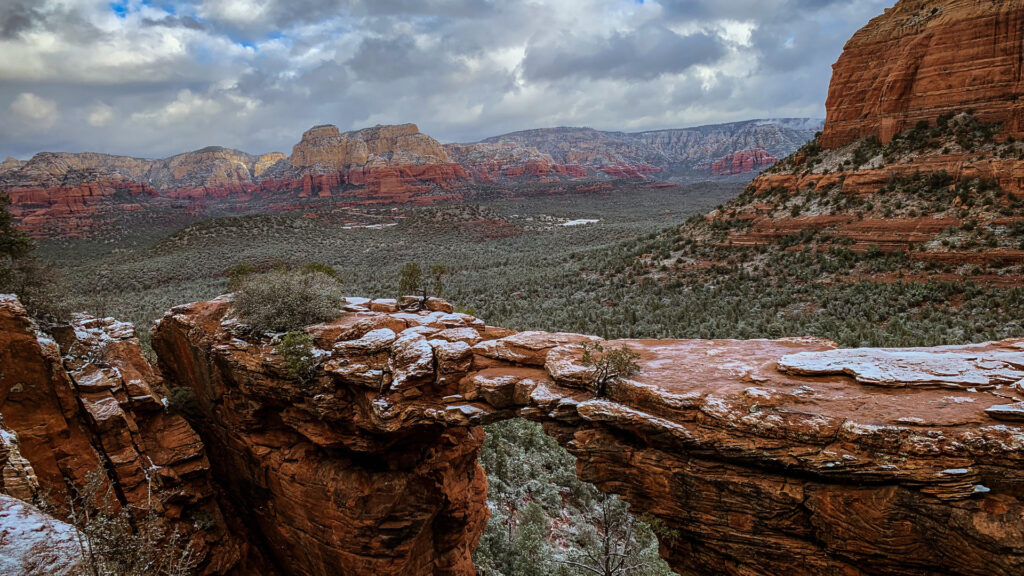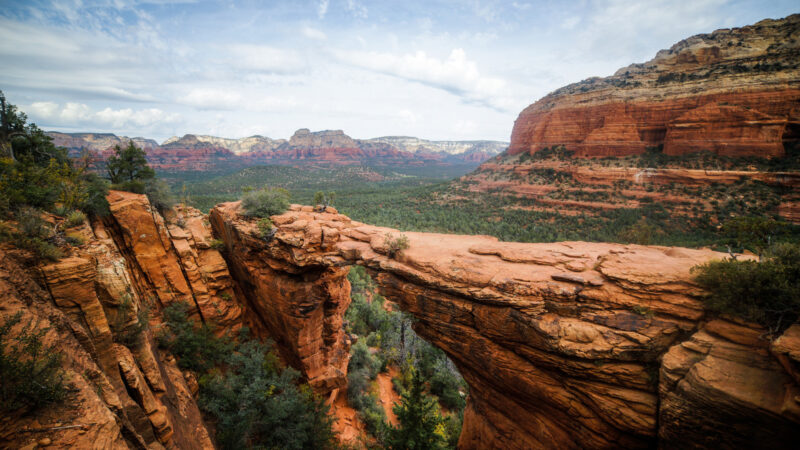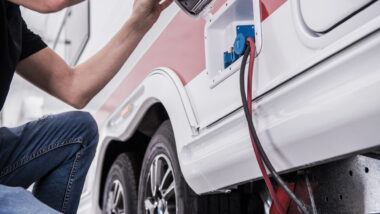Table of Contents Show
Sedona, Arizona, has eclectic vibes and immaculate scenery. So is Devils Bridge in Sedona worth visiting?
You may have heard of Thor’s Hammer, Delicate Arch, the Narrows, Horseshoe Bend, or Antelope Canyon if you’re familiar with the Southwest region of the United States. These iconic natural features make up some of the best of our country’s landscape.
And the majestic formations lure us year after year to explore and fall in love with nature. Devil’s Bridge in Sedona is another such natural wonder.
Let’s learn why you should plan to hike this trail when visiting central Arizona. Let’s dive in!
What Is Devil’s Bridge Sedona?
One of the most popular hiking trails and Instagram-worthy photos is at Devil’s Bridge Sedona.
Surrounded by the red rocks and mesas of northern Arizona, Devil’s Bridge is a 45-foot-long natural rock bridge.
It stands about 54 feet tall and is famous for the numerous photos of hikers who venture across and stand in the center.
Where Is Devil’s Bridge?
You’ll find Devil’s Bridge in Sedona, Ariz., in the Coconino National Forest off Highway 89A and Dry Creek Road.
Highway 89A runs from the east, down to the south, and then west, passing through Sedona and just north of Red Rock State Park. Devil’s Bridge is a little over an hour south of Flagstaff.
Furthermore, this area has dozens of trailheads, including Bear Mountain Trail, Long Canyon Trail, Brin’s Ridge Trail, and more.
How to Get to Devil’s Bridge
You can get to Devil’s Bridge Sedona a couple of ways. First, if you have a 4×4 vehicle, you can park at the trailhead and just take the 2-mile hike to the natural rock bridge.
Dry Creek Road isn’t for 4×2 or low-clearance vehicles. This rocky dirt road ventures off Highway 89A and takes you to the parking lot.
If you have a 4×2 vehicle, park at the Dry Creek Vista Trailhead. From here, you must walk to the Devil’s Bridge Trailhead, making the total loop about 4.6 miles long.
Another option for 4×2 vehicle owners is to park at the Mescal Trailhead parking lot. From here, you’ll walk about 1 mile to get to the Devil’s Bridge Trailhead for a 4.2-mile round-trip hike.
Is There Parking at Devil’s Bridge Sedona?
Parking at the Dry Creek Vista Trailhead is very limited.
However, Sedona city offers a free shuttle service from a Park and Ride in central Sedona to the Dry Creek Vista Trailhead. It only operates Thursday through Sunday but provides a great way to avoid the parking challenges of the small lot.
Owners of high-clearance 4×4 vehicles can drive closer to the Devil’s Bridge Trailhead. As mentioned before, it’s a rocky dirt road with huge ruts, so don’t venture along this road unless you have an appropriate vehicle.
Keep in Mind: Camp in Arizona for free with any sized RV with these Free Camping in Arizona!

About the Devil’s Bridge Trail
The Devil’s Bridge Trail is considered easy except for a steep climb at the end. You must climb stairs to reach the natural rock bridge.
This is not a wheelchair-accessible hike nor for people with knee problems. Also, remember that although dogs are allowed on the trail, these steep stairs might not be suitable for all furry friends.
From the Dry Creek Vista parking area, follow the marker for Devil’s Bridge Trail. It’s about a mile or so before you reach the trailhead.
This makes the total loop about 4 miles with an elevation gain of over 500 feet. Walking to the Devil’s Bridge Trailhead has minimal elevation gain.
However, once you hit the trail, it’s a constant uphill climb for about a mile with a steep incline and stairs at the end to reach the iconic bridge.
Can You Walk Across Devil’s Bridge?
You can walk across Devil’s Bridge Sedona. In fact, you’ll likely have to wait in line to do so. Don’t expect to arrive at Devil’s Bridge to enjoy solitude. It’s one of the most popular attractions in Sedona.
Crowds tend to pick up between 10 a.m. and 4 p.m., so arrive early. You’ll also encounter fewer people if you can hike on a weekday. But you also don’t have to walk across the bridge to enjoy it. It’s a beautiful sight in itself.

When Is the Best Time to Visit Devil’s Bridge Sedona?
When you’re trying to capture that perfect Instagram photo, expect to wait with dozens of other people. Sometimes this can take away from the majesty and beauty of Devil’s Bridge.
But don’t let crowds keep you from making the hike. It’s totally worth it! As mentioned earlier, if you can go out on a weekday early in the morning, you’ll have better luck finding a parking spot and fewer people.
This part of Arizona sees snow in the winter, so it’s best to avoid this trail because of its uneven terrain after a snowstorm. Furthermore, you don’t want to hike in Sedona in the summer because of the extreme heat.
For the prime season, plan to go in April and May. The temperatures are mild and comfortable, usually in the 70s and 80s. Or you can wait until October for similar weather.
Keep in Mind: Are Arizona National Parks Worth Visiting? Let’s find out!
Is Devil’s Bridge Sedona Worth It?
There’s something about natural wonders that captivate our hearts. From the depths of the Grand Canyon to the peaks of the Rocky Mountains, we feel drawn to beautiful landscapes.
Devil’s Bridge Sedona is one of those iconic places to visit while in Arizona. Like the hoodoos of Bryce Canyon or the arches of Arches National Park, this natural wonder lures millions of visitors annually.
As long as you can take the crowds and the interrupted quietness of the central Arizona landscape, you’ll likely enjoy the hike to see this natural rock bridge.
Have you ever walked across Devil’s Bridge and gotten that Instagram-worthy photo?







I would not take a chance walking across that bridge. Looks like it could fall at any moment.